Historically, riprap, retaining walls, and other hardened structures have been the dominant means by which erosion has been controlled along the shorelands of our lakes, rivers, and ocean waters.
Although effective and necessary in some cases, these structures can have unintended consequences such as intensifying erosion next to the structure, degrading habitat for plants and animals in the important riparian zone, and inhibiting natural processes like sediment transport that are foundational to a properly functioning ecosystem.
I have witnessed these impacts firsthand during surveys that I’ve conducted previously in my career where excessive riprap usage has altered the natural functions of streams to the point where no habitat features remained. In these cases, the riprap-armored banks had artificially straightened the channel and reduced the amount of woody debris that fell into the streams, preventing the formation of deep pools and riffle areas where fish populations thrive.
The rise of nature-based shoreline stabilization techniques in recent years has provided a practical alternative to these traditional hardened structures that minimize negative impacts while still providing the same erosion control benefits.
Nature-based shoreline stabilization is defined as the use of plant-based biodegradable materials and vegetation to secure sediment and prevent erosion. Non-biodegradable materials such as metal anchors or cables are often used in conjunction with these plant-based materials to temporarily anchor them until planted vegetation takes root, after which they can be removed.
The Natural Resources Council of Maine is supporting updates to shoreline stabilization rules being considered by the Board of Environmental Protection because they are a big step toward embracing nature-based solutions as the preferred method of shoreline stabilization.
The proposed reforms would encourage the use of natural products over hardened structures by:
-
- Making the requirements for riprap and other hardened products more stringent than those for nature-based solutions.
- Requiring that the “alternatives analysis” conducted through the Natural Resources Protection Act be carried out with the rebuttable presumption that nature-based solutions can practically stabilize a shoreline for non-extreme cases of erosion.
- Adequately defining what materials and products fall under the category of nature-based solutions.
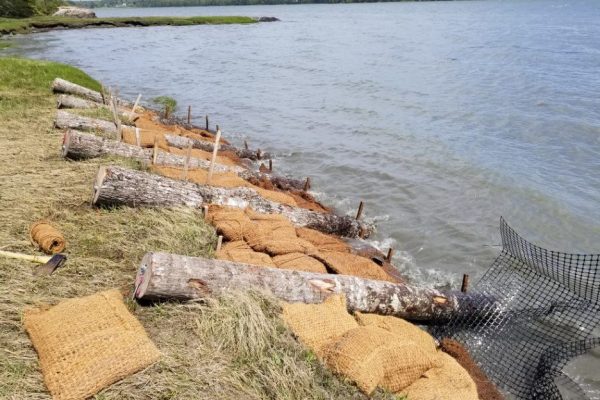
Construction of a nature-based shoreline stabilization project on Maquoit Bay in Brunswick (from maine.gov, Image from D. Bannon, GEI and P. Slovinsky, MGS)
The new rules also set important limits and restrictions for riprap and other hardened structures, only allowing them to go through the expedited Permit by Rule process if necessary to protect key infrastructure. We believe that the limitations and restrictions outlined in the rules are sufficient to prevent unnecessary riprap projects that could be harmful to wetlands and waterbodies from being permitted.
We shouldn’t just fall back on the status quo or do what makes us comfortable when a more sensible, effective solution emerges – and that’s the case here. Nature-based solutions are a proven and practical approach to stabilizing shorelines in low-energy environments in a way that preserves key ecosystem functions, so it just makes sense that they should be encouraged!
Since the use of nature-based solutions is still a relatively new practice within Maine, the Department of Environmental Protection, whose experts proposed the rules changes, has already created and shared specific guidance for municipalities and contractors to better support adoption. One example of this is the Department’s OUR SHORE checklist, which provides a framework for identifying the appropriate nature-based stabilization tools for a given site.
This proactive approach to education and outreach will ensure that engineers and contractors are equipped to change their behavior to be more environmentally responsible and will ultimately lead to the rules being successful in achieving their intended goals without undue burden to landowners.
As the shorelines of our lakes, rivers, and ocean waters see increased pressures from development and climate change, solutions like nature-based shoreline stabilization techniques that can be quickly permitted and built just make sense. We all value healthy, vibrant ecosystems and it’s simple steps like this that help to preserve these critical shoreland habitats for this generation and the next.
—Luke Frankel, NRCM Staff Scientist
Banner photo: Natural shoreline of Square Lake, Aroostook County, by JMonkman/NRCM
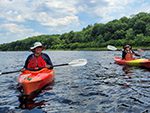
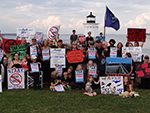
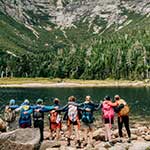
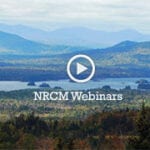
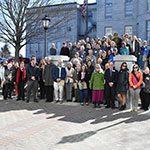

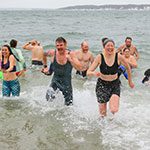

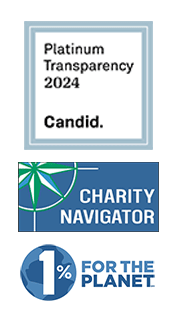

Leave a Reply